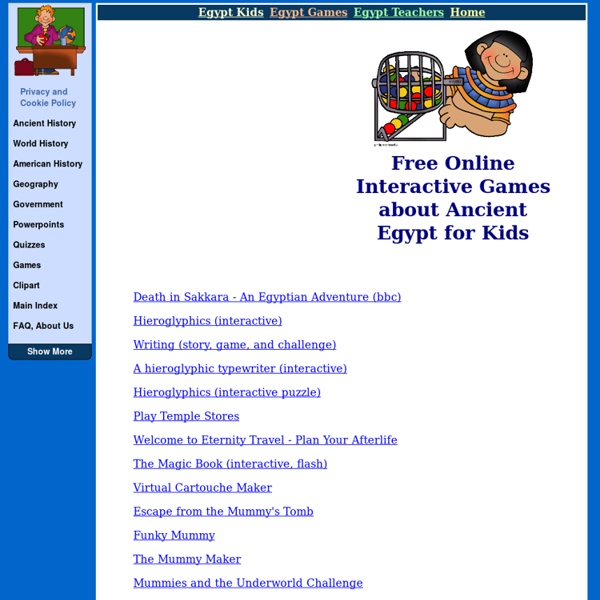



The Egyptian Number System Learn about the Egyptian Number System © 2012 This website is produced by the Student Recruitment, Admissions and International Development Division at The University of Manchester Welcome to EternityTravel.com What do we do? We give the discerning, God(s)-fearing ancient Egyptian consumer the tools and information to plan for a safe, speedy, comfortable trip to the afterlife. Here on EternityTravel.com, you can: rent or buy the perfect tomb schedule reliable mummification services purchase a quality mummy case and order all the necessary Eternity Extras … all in a few easy steps, with no lines or waiting! How does it work? The pharaoh has given you 3300 debens to spend on burial preparations. But, remember: the dangers of the underworld are everpresent, so read carefully and plan your journey wisely! All sales final — no returns!
Ancient Times This lesson plan may be used to address the academic standards listed below. These standards are drawn from Content Knowledge: A Compendium of Standards and Benchmarks for K-12 Education: 2nd Edition and have been provided courtesy of theMid-continent Research for Education and Learningin Aurora, Colorado. Grade level: 3-5Subject area: historyStandard: Understands selected attributes and historical developments of societies in Africa, the Americas, Asia, and Europe.Benchmarks: Knows about life in urban areas and communities of various cultures of the world at various times in their history. Knows significant historical achievements of various cultures of the world. Grade level: 3-5Subject area: visual artsStandard: Understands the visual arts in relation to history and cultures.Benchmarks: Knows that the visual arts have a history and a specific relationship to various cultures. Identifies specific works of art as belonging to particular cultures, times, and places.
Home Page Wheel Of Pharaoh This lesson plan may be used to address the academic standards listed below. These standards are drawn from Content Knowledge: A Compendium of Standards and Benchmarks for K-12 Education: 2nd Edition and have been provided courtesy of theMid-continent Research for Education and Learningin Aurora, Colorado. Grade level: K-4Subject area: HistoryStandard: Understands selected attributes and historical developments of societies in Africa, the Americas, Asia, and Europe.Benchmarks: Knows significant historical achievements of various cultures of the world (e.g., the Hanging Gardens of Babylon, the Taj Mahal in India, the pyramids in Egypt, the temples in ancient Greece, the bridges and aqueducts in ancient Rome). Grade level: 5-6Subject area: Historical understandingStandard: Understands the historical perspective.Benchmarks: Understands that specific individuals had a great impact on history.
Course Descriptions Courses All courses include a weekly live webinar component. The current webinar schedule is available on the enrollment page. Literature 7th grade Lightning Literature from Hewitt Homeschooling, adapted to fit the needs of young, gifted 21st-century learners. Lessons include: plotintroduction to poetrydialogueautobiographycharacterization Learning activities include regular writing to communicate ideas, videos and multimedia, web 2.0 tools to synthesize new concepts, and live webinars. Year-long course condensed into a single semester. Required books: Lightning Lit 7 Student Guide by Elizabeth KamathStories and Poems for Extremely Intelligent Children of All Ages by Harold BloomThe Adventures of Tom Sawyer by Mark TwainAlice's Adventures in Wonderland by Lewis CarrollThe Story of My Life by Helen KellerAll Creatures Great and Small by James Herriot Most books are readily available at your local library, or can be purchased from our resources page. Grammar/Vocabulary Students will:
Local Support - Gifted Homeschoolers Forum Because sometimes what you need most is the support of others near you (or sharing your beliefs)… Regional Mailing Lists and Social Media Groups - Faith-Based Groups - Individual Contacts by Region/Faith/OtherQuestions? Our Regional Contacts Coordinator is Carissa Leventis-Cox. Regional Mailing Lists and Social Media Groups AZ - Palo Verde Homeschoolers — Online secular community for Arizona parents with inquisitive and imaginative children. Share local event information, organize outings, and discuss gifted/spirited-child issues.AZ - Gifted Homeschoolers of Central Phoenix — Social group only, (no classes or co-ops) getting together for field trips, travel, adventures, holiday celebrations, community service, and spending time together.CA - Asynchronous Minds — Local support group for families of gifted children, many of whom have chosen alternative educational options. International Faith-Based Groups Individual Contacts — When you need an individual to answer your questions. United States
Lesson Plans Chapter 1: Matter—Solids, Liquids, and Gases Students are introduced to the idea that matter is composed of atoms and molecules that are attracted to each other and in constant motion. Students explore the attractions and motion of atoms and molecules as they experiment with and observe the heating and cooling of a solid, liquid, and gas. Chapter 2: Changes of State Students help design experiments to test whether the temperature of water affects the rate of evaporation and whether the temperature of water vapor affects the rate of condensation. Chapter 3: Density Students experiment with objects that have the same volume but different mass and other objects that have the same mass but different volume to develop a meaning of density. Chapter 4: The Periodic Table & Bonding Students look more deeply into the structure of the atom and play a game to better understand the relationship between protons, neutrons, electrons, and energy levels in atoms and their location in the periodic table.
Edventure More – Inspiring the playful pursuit of enrichment in the next generation